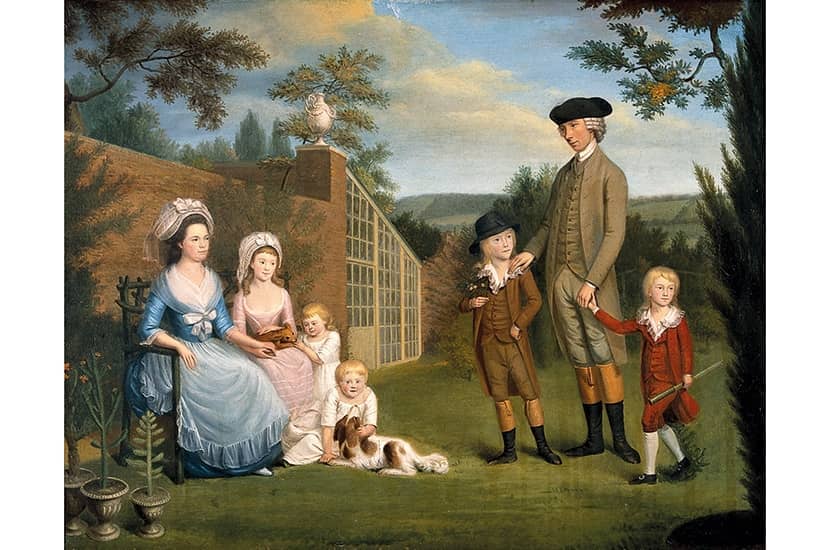On 23 May 1804, two months before his daughter’s wedding, John Coakley Lettsom threw open his estate in Camberwell. Some 800 guests made their way to Grove Hill, with its panoramic views across the Thames to London. A leading doctor and noted philanthropist, a prolific author on matters medical, social and moral, Lettsom was famously convivial. But if any of his guests had been expecting music, dancing and cards, they were in for a disappointment.
Lettsom was a Quaker — though not of the strictest variety — and the evening’s entertainment centred on ‘rational pleasure’. Guests were invited to view the shells, corals and minerals on display in his museum, to inspect the natural history volumes in his library and admire the blooms in his conservatory. Only then could they move on to the refreshments, served in an elegant garden room decked out as a rustic bower.
Sixty-four beehives, each named after a country, formed a little world buzzing with industry
Just ten acres in extent, Grove Hill boasted an abundance of features, like a scaled-down version of the royal gardens at Kew. There were formal beds with plants laid out in Linnaean order, a Shakespeare walk, classical statues and a pond with a fountain. In the vegetable garden, tortoises ranged through the lettuces. A small farm conducted agricultural experiments (notably on the mangel-wurzel, a root vegetable particularly championed by Lettsom). The menagerie housed a bear, flying squirrels and a great white American owl. Sixty-four beehives, each named after a country, formed a little world buzzing with industry. There was even an astronomical observatory, adorned in picturesque fashion with oak branches and entwined creepers. The estate was open to members of the public and Lettsom published a guide book to conduct visitors around the grounds.
Grove Hill assumes pride of place in Clare Hickman’s well-researched and gorgeously illustrated The Doctor’s Garden. Building on Penelope Hunting’s meticulous work on Lettsom’s estate, Hickman starts each chapter with Grove Hill, before ‘meandering through the metaphorical shrubberies to explore other gardens, collections and experiences’. But this is wandering to a purpose. In focusing on gardens associated with the medical profession, Hickman uncovers the close links between horticulture, botany and medicine in the 18th century. Plant products were central to the materia medica, and botany formed part of the medical curriculum. With this training, many doctors devoted their leisure hours to plants and gardens.
A number of the estates featured in Hickman’s book were Quaker-owned. Lettsom himself acquired his interest in horticulture from his Quaker mentor Dr John Fothergill, who established a splendid garden at Upton House in Essex (which survives to this day as West Ham Park). One of the richest doctors in the country, Fothergill joined other wealthy patrons in sponsoring plant-collecting expeditions to the Alps, America, the West Indies and Africa. According to Sir Joseph Banks, the great doyen of 18th-century science and unofficial director of Kew Gardens, ‘no other garden in Europe, royal or of a subject, had nearly so many scarce and valuable plants’. At Fothergill’s death in 1780, Lettsom acquired some 2,000 specimens to add to his own collection. Like Fothergill, Lettsom used his horticultural activities to boost his social and scientific prestige.
Both men drew on Quaker and medical networks to build their collections and promote botanical and horticultural projects. They supported the Quaker apothecary William Curtis in his 1777 scheme to establish the London Botanic Garden on a plot near the current site of Waterloo station (which survived until 1808, when it moved to Sloane Street, Chelsea). The garden was open to subscribers who paid a fee of two guineas a year. Plants were identified with colour-coded labels listing Linnaean and English names: medicinal plants in yellow, food plants in blue, agricultural crops in green, natural dyes in red, and poison in black. A decade after the garden’s foundation, Curtis launched the Botanical Magazine to illustrate ‘the most ornamental Foreign Plants, cultivated in the open ground, the Green-House, and the Stove’. Remarkably, Curtis’s Botanical Magazine continues to this day, the world’s longest-running botanical periodical.
In her stimulating and original study, Hickman turns away from the traditional focus of garden history — great aristocratic and royal estates — to consider more modest gardens, mostly located on the periphery of London. Rather than discussing garden design or aesthetics, she supplies accounts of sporting activities (James Boswell frequently played bowls at Grove Hill) and exotic creatures (American bullfrogs kept escaping from Fothergill’s ponds).
While such details are fascinating, Hickman also broadens the focus to situate the gardens in the wider world. She traces professional networks that spanned the globe, and reminds us that 18th-century plant-collecting travelled along the same routes as the slave trade. In reconstructing and animating landscapes, now mostly buried under city streets, Hickman has recovered a lost world of medical gardens: places of instruction and experiment, sociability and pleasure.






Comments